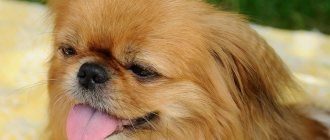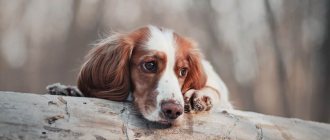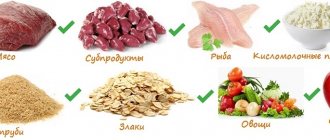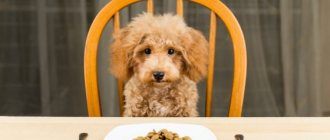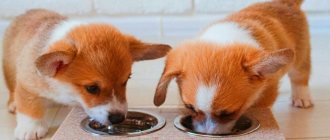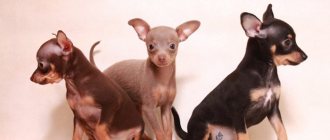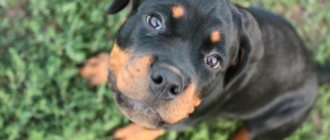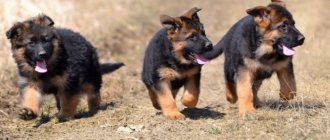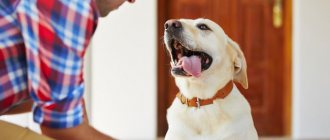/ Dogs / Feeding dogs / What and how often should a Pekingese be fed
0
9222
Article rating
After purchasing a Pekingese, new owners ask the logical question of what to feed the Pekingese. Feeding is an important part of a small Pekingese puppy's life. What your pet eats will determine its appearance and health.
What to feed your Pekingese
Principles of proper nutrition for the Pekingese
The Pekingese is one of those breeds that needs a varied diet. The problem of nutrition is especially acute for owners of show dogs, where it is extremely important to show an ideal shape and well-groomed coat, both in photos and in life.
How can you tell if your dog is eating enough? It is not difficult to check this; for this you need to check two factors:
- Pet body structure. Normally, you can easily feel the spine and ribs under the muscle tissue.
- Condition of the coat: The coat must be thick and rough to the touch. Externally, the coat should have a shine, which indicates the excellent health of the Pekingese.
It is important not to overfeed the Pekingese, as the breed is prone to gaining excess weight. For this reason, the preparation of the diet is approached with all responsibility, taking into account the dog’s inactivity.
Unfortunately, every fifth owner faces the problem of obesity, although he himself is the culprit of this problem. It is worth saying that the appearance of extra pounds in a Pekingese is fraught not only with a decrease in physical activity, but can lead to other, more dangerous diseases:
- Heart pathologies
- Poor digestion
- Short life expectancy
Choosing a place and utensils for feeding
Even before you bring your pet into the house, you need to prepare all the equipment. The dog's feeding area must be stationary. It is better to arrange it in the kitchen or dining room. You should not place your pet's plates near the bed. It is better to choose stable bowls; a more suitable material is ceramic, but metal (stainless steel) is also suitable.
It is not recommended to give preference to dishes made of plastic, as small puppies tend to chew everything, and such material breaks easily, and the baby can swallow a sharp piece.
Since the Pekingese has a wide and short muzzle, you should choose a shallow bowl with a large circumference and a convex bottom. You can place a rubberized mat or a large tray with sides under the plates to prevent your pet from dragging food all over the floor. This stand is easy to wash and disinfect.
The main components of the Pekingese diet
As mentioned earlier, representatives of the Pekingese breed should receive a varied diet. For this reason, it is worthwhile to dwell in more detail on each food group when answering the question of what to feed your Pekingese at home.
Meat, fish and offal
In order to keep your pet in excellent physical shape, you should give preference only to lean varieties of meat. It can be:
- Beef (veal)
- rabbit
- chicken
- turkey
- Chicken giblets, however, only as an addition to a meat dish
Dog owners often wonder if it's okay to give dogs a lot of raw meat? Yes, you can feed dogs, including Pekingese, raw meat. However, you can only do this if you are confident in its freshness and quality. Otherwise, it is recommended to pour boiling water over the meat product or simply boil it.
Several times a week, meat can be replaced with fish. The requirements for fish are the same as for meat; it must be lean and cleaned of all bones. Judging by the reviews of Pekingese owners, dogs eagerly eat horse mackerel and mackerel, especially since such fish meets the requirements described above.
Important: Do not cut meat and fish finely; the dog must crush large pieces itself, thereby developing the jaws. When choosing fish, it is recommended to avoid pollock. This fish contains a mineral responsible for binding iron, which can affect the health of the Pekingese.
Porridge in the Pekingese diet
We can say unequivocally that Pekingese eagerly eat cereal porridge. There are no special restrictions or recommendations, so in this matter you can be guided by your pet’s taste preferences. The choice of cereals is wide: buckwheat, rice, rolled oats, barley, millet and so on. The only nuance worth mentioning is that the porridge must be cooked, that is, not instant. Try not to overcook the porridge so that it does not resemble jelly in consistency; Pekingese do not like this.
Vegetables and fruits on the menu
Despite the usefulness of vegetables, not all types are eaten by Pekingese. The most acceptable ones include the following:
- Cauliflower
- Broccoli
- Zucchini
- Buryak
- Carrots (eaten with great pleasure)
- Greenery
All of the above vegetables can be included in the Pekingese diet, both raw and boiled.
As for fruits, they should not become the pet’s main diet. It is recommended to use them as a treat. From the huge assortment of fruit ones, you should give preference to the most common types, avoiding the exotic. Pekingese enjoy eating apples, apricots and peaches.
Milk and eggs
Dairy products are a storehouse of protein, which dogs need so much, especially during periods of active growth. It is extremely important for your little Pekingese puppy to get enough calcium. To do this, it is necessary to periodically give the dog calcined cottage cheese. You can prepare it correctly with your own hands at home. To do this, you will need 1 liter of cow's milk and 2-4 tablespoons of calcium chloride (can be purchased at the pharmacy). The cooking recipe includes the following steps:
- You need to bring the milk to a boil
- Add calcium chloride, stir
- After cooling, strain the milk through cheesecloth.
In addition, the Pekingese should be given regular milk (up to 2.5% fat), cottage cheese, kefir and hard cheese (no more than 100 g per week).
How many eggs can a Pekingese eat? You can give eggs to your Pekingese, but only the yolk and always boiled.
Recommendations from experts
The following advice from veterinarians and dog handlers will help you properly feed puppies and adult Pekingese:
- During the first molt, when baby hair changes to adult hair, the menu is enriched with algae, mussels, oysters and other seafood. However, you need to remember that you cannot feed your Pekingese these foods at an earlier age.
- In summer, an adult Pekingese should eat more fiber, and in winter, protein foods.
- It is not recommended to rely heavily on buckwheat, because it can cause urolithiasis.
- The bowl is removed 20 minutes after the start of feeding. If there is food left in it, the portion size is reduced, and if the dog continues to lick the empty dishes, it is increased.
- You should not offer your pet treats often, because then he will refuse to eat regular food.
- Sedentary adult Pekingese dogs should consume about 300 calories per day. With moderate activity, the energy value increases to 400 calories, and with high loads - up to 600 calories.
Ready-made food - pros and cons
When talking about the nutrition of dogs or cats, we cannot fail to mention ready-to-eat foods. Their range today is wide - different forms of release (dry or wet), the presence or absence of vitamins, additional medicinal functions, and so on. You can feed an adult Pekingese with both homemade food and ready-made food. This feeding option has one significant advantage - the needs of a specific breed are correctly taken into account when producing food. Plus, you don't have to waste time cooking.
Speaking of Pekingese, you need to choose food for long-haired dogs taking into account individual needs. There are categories of dogs that require special nutrition, these are:
- Pregnant bitches
- Nursing Pekingese
- Older dogs
- Pets with allergies
- Puppy food (homemade food is better than feeding your Pekingese puppy store-bought food)
Giving preference to the best store-bought feeds, it is necessary to ensure a constant availability of water. Based on the opinion of Pekingese owners, this breed is extremely picky and does not eat every Pekingese food. It may happen that the Pekingese refuses to eat wet food TM Chappi, but they eat dry food TM Purina with pleasure. Experienced breeders advise feeding Pekingese with Eukanuba TM food or using Hill's. These brands are classified as premium.
If for one reason or another you decide to switch your dog to homemade food, it is better to keep in mind that this should be done gradually. On average, the transition will take about two weeks.
What to choose: dry or natural food?
Each owner decides for himself which type of food to choose for his pet. Some people like to cook a variety of natural and healthy dishes for their pet every day. Some people don’t want to waste time at the stove and buy ready-made food. In this case, both are right; the main thing is that the dog receives all the necessary nutrients, minerals and vitamins along with its food.
Important! An adult Pekingese does not need to eat too often. Breakfast and dinner will be enough for him.
Feeding Pekingese natural food
The basis of the Pekingese's natural diet should be filleted meat and small pieces. So, these dogs can be offered turkey, chicken and rabbit meat, as they have a low fat content and are better absorbed by the body. Cartilage and bones should not be offered to these dogs with a unique muzzle structure.
Important! It is best to give sea fish, after removing the bones from it.
Also, the menu of these dogs should include carrots, eggs, broccoli, garlic, and blueberries. These products will help avoid vision problems. Tomatoes and carrots are offered raw. Beets, zucchini, and cabbage should be subjected to heat treatment. You can and should add a little chopped parsley to prepared dishes. As for fruits, Pekingese can eat a piece of peach or apple.
The Pekingese can't do without porridge. Veterinarians recommend giving them rice, millet, buckwheat and oatmeal. You need to be careful with buckwheat, as excessive consumption can cause the development of urolithiasis. From milk you can offer kefir, cottage cheese, fermented baked milk.
Important! A dog on a natural diet needs foods enriched with omega-3 fatty acids, glucosamine and chondroitin.
Feeding wet or dry food
If you want your pet’s diet to consist of commercial food, purchase both wet canned food and dry food for it. Constantly feeding wet food can cause gum problems and can be used as a treat.
Important! Dogs that are fed dry food should also receive a portion of fermented milk products.
Choosing a good dry food for your Pekingese without the help of a veterinarian is difficult. Only a specialist will tell you which product from the breed line is suitable for your pet.
What not to feed a Pekingese
What should you not feed your Pekingese? When cooking, it is better not to add any spices, including salt. As mentioned earlier, fatty foods are contraindicated for this breed, as they contribute to rapid weight gain, which is undesirable. Other foods that have no place in the Pekingese diet include:
- White cabbage
- All types of legumes
- Onion
- Potato
- Bakery products
- Chocolate
All of the above products can cause disruption in the pet’s digestive system, most often this is flatulence.
Water in a puppy's diet
Water plays a major role in a puppy’s diet. If there is a lack of water, the puppy quickly develops:
- Blood thickening.
- Slowing metabolism.
An adult dog can withstand the above factors for several days, but a puppy risks dying in a matter of hours. What should you do to avoid putting your Pekingese puppy in danger? Buy 2-3 water bowls at once. Place drinking bowls in areas to which the baby has constant access. Be sure to make sure your puppy drinks water, especially if he is not yet 2-3 months old. At this age, puppies are reluctant to drink, even if they are thirsty.
Pekingese feeding rules
In addition to all of the above, you should adhere to the feeding rules, this is the only way you can be sure that your pet is healthy.
- The Pekingese should eat twice a day (preferably once after one year), and the feeding hours should remain constant.
- If your Pekingese doesn't start eating after you put the bowl out for your dog, don't force it. Save feeding your Pekingese until next time.
- Make sure food is fresh and slightly warmed
- Do not feed your pet liquid soups. This kind of food is difficult for Pekingese to eat due to the special structure of their muzzle.
- Try not to spoil your dog so that sooner or later he will refuse regular food.
- Pekingese dogs need additional vitamin complexes, which are best purchased at pet stores and veterinary pharmacies.
Necessary vitamins and nutrition
If you have chosen to feed your beloved pet high-quality dry food, then you most likely will not need vitamin supplements and nutrition, since the food itself is balanced and contains all the substances necessary for the dog’s body.
Let us remind you that natural nutrition means feeding your dog freshly prepared food. The diet should be varied. With a balanced diet, foods contain the required amount of vitamins. If you feed your pet correctly, his health will be excellent and he will not need vitamin supplements.
There are times when a dog additionally needs vitamin complexes. But it is important to remember that both a lack of vitamins and their excess can have negative consequences. Tablets or drops are prescribed in cases where there is a weakened condition: heavy physical activity, a nursing bitch. For a pet, the content of vitamins A, B, D, E, K, as well as macro- and microelements in food is very important.
If you take a closer look at how the Pekingese behaves and what it looks like, you can find out what vitamins it lacks.
If you notice at home that your pet is picking up cigarette butts, instead of scolding him for this, it is better to take care of adding foods with vitamin P to his diet. Your dog clearly does not have enough of it. It is found in cabbage and green salad.
Does your pet fiddle with shoe insoles and unclean socks? This is a signal that there is not enough vitamin B. Add fresh meat to your diet.
Is your dog chewing chalk or dirt? This is a lack of calcium. Add more cottage cheese to your diet, and oatmeal for breakfast.
Have you noticed that the Pekingese tries to eat its own or other people's feces? There is no use in scolding. This behavior indicates that the pet has a lack of vitamin B12 in its body.
Similar article: How long do Pekingese live on average and what does it depend on?
Prohibited Products
There are foods that are strictly forbidden to give to Pekingese:
- tubular hollow bones;
- sugar, chocolate, sweet pastries
- salt, spices;
- smoked and fried foods;
- pork;
- potato;
- flour products;
- citrus fruits, grapes, raisins, avocados;
- hot or stale food.
It is also not advisable to give representatives of this breed fresh bread, pasta, bananas, onions and garlic. It is not necessary to exclude these foods completely. There must be moderation in everything.
